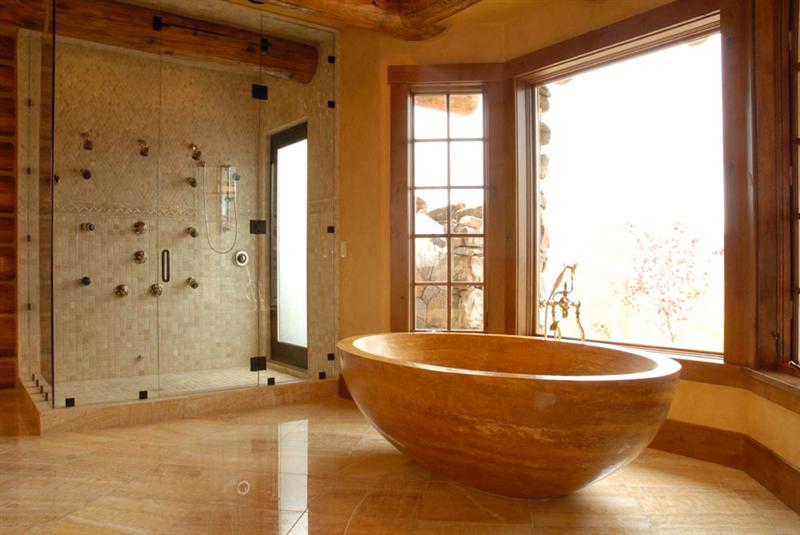
Natural stone from a quarry to manufacture is environmentally friendly in the building industry for thousands of years. From a sustainability perspective, coming from nature brings natural stone many positive features over its counterparts.
We already talked about “What is sustainable and eco-friendly construction?” in the other article. We also mentioned “How sustainable is natural stone?” in terms of this point of view. In this article we get together 14 REASONS to prove the sustainability of natural stone. Let’s see them closely:
1. Stone is originally from the earth.
Stone is ready-made on the planet that is the outcome of a combination of heat and pressure over mineral composition for millions of years. All that is required is to dig it out, process it and install it.
2. Natural stone is the primary green material.
It is crucial to design for people who decide what materials are used in construction projects. The fact is that no other product in the construction industry has such a green footprint. Essentially, the question is: Do you want to buy an original or a substitute?
3. The beauty comes from nature.
Stone has natural advantages compared to its competitors, such as glass, ceramics, cement, quartz, porcelain, and other substitutes that can’t replicate natural stones’ authentic beauty. Natural stone can compete easily with different veins, colours, types, textures, patterns and composition, allowing them to be used in a wide range of designs and applications.
4. No harmful chemicals or toxin is contained in the stone.
One of the most critical agents is for sustainable design is to use natural stone that contains no harmful chemicals or toxins. So you can rest assured that your interior environment will be healthy, an essential component of sustainable design.
5. Stone is very durable
Durability is essentially essential when considering sustainable material that means little or zero waste from the quarrying stage through to its installation. After it is installed, the lowest abrasion values and high-pressure resistance can stand up to different forms of applications.
6. Stone has infinite longevity.
Once natural stone is installed with adequate care and maintenance, it will never need to be replaced, age gracefully and still stunning. Natural stone has been proven to be the most ancient and long-lasting material by being used for thousands of years commercially or residentially projects.
7. Stone pays for itself.
Natural stone will intensify the value of the building, but it will also compensate the cost by being there for an extended period and having minimal future costs. Natural stone might be slightly more expensive than its human-made counterparts, but with this approach, it is clear to say that “stone is affordable”.
8. Stone quarries and fabrication are eco-friendly.
The technology used in the quarries and factories has been improved through the decades all over the world. This development in the industry prevents any unnecessary environmental damages during all processes of production. Modern quarrying techniques eliminate harmful practices such as explosives. Quarries and factories have adopted to reduce and reuse the amount of water while extracting and cutting. We can confidentially say that the production of stone leaves no harmful waste to nature, and there is a minimal environmental impact that is not for the long term.
9. Stone can be found almost in every region.
Being able to reach natural stone resources and produce the materials locally and regionally makes it cause fewer pollutant gasses during transportation of the materials. And besides, operating the quarries in the same region for several decades allow the production to reduce environmental impacts with a small footprint.
10. Natural stone has got the highest energy efficiency.
When glass facades are compared to natural stones ones in terms of energy efficiency, it is technically proved that the heat transfer coefficient of natural stones is far below that of glass ones. Because the stone has lower heat conductivity comparing to glass. Therefore it absorbs, stores, and radiates heat means less heating cost in winter and increases ventilation to circulate the air and keep the building cool means less cooling cost in summer.
11. Cleaning stone is easy and harmless to the environment.
Natural stone keeps its beauty as time goes by and gains more with age. After saying all that, we can easily estimate how much care we need to pay to the stones. Simply essential soap and water will do the work. But there are also pH neutral natural stone cleaners approved to meet sustainability standards, with no harmful chemicals and no pollutants. Both ways are affordable, accessible and environmentally friendly.
12. Stone offers minimal maintenance.
Natural stone requires very little maintenance. Sealing occasionally will help the stone stay aesthetic and functional. Nearly all-natural stone sealers are water-based and environmentally friendly. When natural stone is damaged, it can be completely restored with an adequate amount of maintenance. Even if the damage is beyond repair, they can be still reused for other purposes.
13. Stone is recyclable and reusable.
Salvaging and recycling natural stone is a sustainable way to validate the material’s useful life. That action saves the energy, water and other sources needed to produce new materials out of raw materials. Recycled and salvaged stone has various uses and applications such as building stones, paving materials, retaining walls, exterior claddings or designed mosaics. If it is not used in architecture, it is still valuable in the construction industry as an ingredient of cement, as gravel fill for landscaping or as a mineral source for plants and soil.
14. Stone is recyclable and reusable in other industries.
. Calcium carbonate can be produced from marble, and because of its antacid properties, it is used in industrial settings to neutralize acidic conditions in both soil and water. It has a wide range of use such as a filler and a coating pigment in paper, plastic, paint, and coating industries, as a dietary calcium supplement, antacid, phosphate binder, or base material for medicinal tablets personal health. It is also used in the food production industry in baking powder, toothpaste, dry-mix dessert mixes, dough and animal feed, and the active ingredient in agricultural lime in agriculture.
